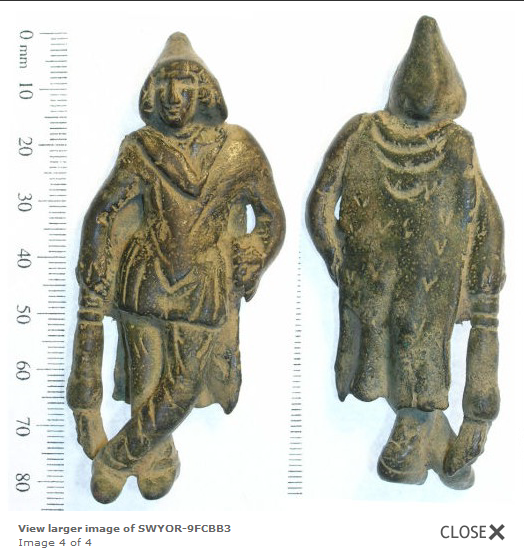
CIMRM Supplement - Copper figurine of Cautopates from "Newton Kyme", Selby, North Yorkshire, Britain.

FIGURINE
Unique ID: SWYOR-9FCBB3
Object type certainty: Certain
Workflow status: Published Find validated and published by finds advisersA Roman copper-alloy figurine depicting Cautopates, Mithras' attendant who symbolises darkness. He is shown holding a torch pointing downwards in his right hand and his left hand is placed on his waist. Cautopates stands facing forwards with his head turned slightly to the right, his legs crossed at the calves and with his left hand placed on the left hip. He wears a Phrygian cap, trousers, a short-sleeved tunic, a cloak and has mid-length tousled hair. The cloak is ornamented with V-shaped motifs and grooved, curved lines on the trousers and tunic represent the folds of the cloth. The figurine is 81.5mm long, 33.9mm wide and 11.2mm thick. It is not free-standing and despite the lack of evidence for an attachment it must have been fixed to a base.
The back of the figurine is almost flat but the decoration on the cloak indicates that it was made to be seen, unlike the back of the similar sized figurine of Cautes, the emblem of light, from Bingerbrück, Mainz-Bingen which is flat but plain and on the reverse bears traces of three rivets for attachment. The Cult of Mithras was popularly followed by the soldiers who were stationed in Britain, though it excluded women. Mithras and his companions are usually depicted in Persian dress, normally consisting of trousers and Phrygian caps. The companions, Cautes and Cautopates represent the opposing attributes of light and dark, or life and death, symbolised by the position of the torch they hold. Cautes holds his up, allowing it to burn, while Cautopates holds his down, extinguishing it.
Mithraic temples had to be near water for purification purposes, and it is interesting that this figurine was found near both a Roman fort and a river. The Cult of Mithras was popular until the advent of Roman Christianity under Constantine. It is therefore likely that this figurine dates from between AD 43 and about AD 307. A depiction in stone of Mithras and his attendants found in London can be seen on page 103 of 'Religion in Roman Britain' by Henig (1984). Despite the popularity of the cult of Mithras, particularly by soldiers stationed in Britain as demonstrated by the concentration of mithraea on Hadrian's Wall, very few metallic votive items are known.
It has not been possible to find a parallel for this figurine. The only other Roman objects discovered in proximity of this object include a small quantity of coarse pottery and a nummus of Constantine I. The findspot lies 1 kilometre from the Roman fort at Newton Kyme and the find may well be associated with its garrison.
Current location of find: Private collection
Subsequent action after recording: Returned to finder
Chronology
Broad period: ROMAN
Date from: Circa AD 43
Date to: Circa AD 307Dimensions and weight
Length: 81.5 mm
Width: 33.9 mm
Thickness: 11.2 mm
Weight: 91 g
Quantity: 1
Date(s) of discovery: Thursday 8th November 2007
Personal details
Found by: This information is restricted for your login.
Recorded by: Ms Amy Downes
Identified by: Mr Dave Weldrake
Secondary identifier: Ms Sally Worrell
Materials and construction
Primary material: Copper alloy
Manufacture method: Cast
Completeness: Complete
Spatial metadata
Region: Yorkshire And The Humber
County: North Yorkshire
District: Selby
To be known as: Newton Kyme
Spatial coordinates
Grid reference source: GPS (from the finder)
Unmasked grid reference accurate to a 1 metre square.
Discovery metadata
Method of discovery: Metal detector
General landuse: Cultivated land
References cited
Henig, M., 1984. Religion in Roman Britain London : Batsford, pp
Menzel, M., 1966. Die romischen Bronzen aus Deutschland III Bonn : , pp33 Taf. 38
| Tweet |